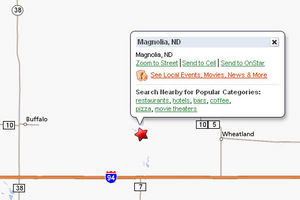Magnolia, North Dakota

Magnolia, North Dakota, according to Origins of North Dakota Place Names:
This Northern Pacific railroad siding with a loading station, three miles west of Wheatland on the main line was constructed in 1886. It was the 24th place in the U.S. named for Dr. Pierre Magnol, a French botanist, for whom the magnolia tree was named. This was an important water station during the years when steam locomotives were in use. A dam was built across a coulee, backing up a small reservoir; several huge underground concrete storage tanks were also here. The water facilities were abandoned in the 1940s.
Barnes-Williams cites Northern Pacific Railroad List of Fargo Division Stations and Origin of Names, by W.D. Pierce as the source of this information.
As recently as 2009, Mapquest and Google Maps both show Magnolia as an extant town, putting their mark at the approximate location of where Magnolia once stood. In the aerial photos, there is little evidence that Magnolia existed, although along the coulee there appear to be some undeveloped areas that may have once been occupied by railroad sidings.
Near the Magnolia townsite is the Magnolia Wildlife Management Area, organized by the North Dakota Game and Fish Department, and consists of 105 acres set aside for nature and hunting purposes.[1]
Geography
4-1/4 miles west of the Campbell beach, a well-defined line marking the former level of Glacial Lake Agassiz, and less than a mile west of Magnolia, and 4 miles east of Buffalo, North Dakota is a smaller, less-defined beach known as Herman beach. This marks the deepest point of Lake Agassiz, above which the lake would have flowed southeasterly into the Mississippi river.
